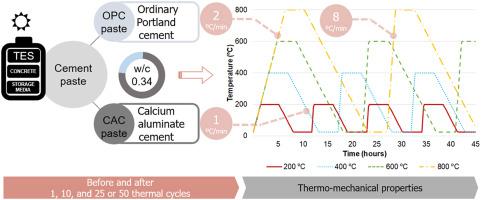Solar Energy Materials and Solar Cells ( IF 6.3 ) Pub Date : 2021-08-16 , DOI: 10.1016/j.solmat.2021.111333 Laura Boquera 1, 2 , J. Ramon Castro 2 , Anna Laura Pisello 1, 3 , Claudia Fabiani 1, 3 , Antonella D'Alessandro 4 , Filippo Ubertini 4 , Luisa F. Cabeza 2

|
Concrete is identified in the literature as a suitable material for thermal energy storage applications, with even innovative application potentials such as storage media in concentrating solar power plants. To ensure a suitable heat transfer among concrete components, the binder material of concrete (cement paste) require further research and understanding to this aim. In particular, the thermal stability of cement paste under temperature cycled conditions arises as a research gap. In this study, ordinary Portland and calcium aluminate cement types were selected using a low water-cement ratio. Thermo-mechanical properties were studied before and after 1, 10, and 25 or 50 thermal cycles at 200 °C, 400 °C, 600 °C, and 800 °C. Although ordinary Portland cement paste showed micro-cracking propagation after 25 thermal cycles from ambient temperature to 200 °C and 400 °C, both cement pastes preserved their integrity, being compressive strength higher in ordinary Portland cement. On the contrary, after 25 or 50 thermal cycles at 600 °C and 800 °C, only calcium aluminate cement preserved its integrity, while ordinary Portland cement revealed a fragmentation status. Despite the compressive strength decrease in calcium aluminate paste at 600 °C and 800 °C, as a result of porosity increase, the properties were maintained after 10 thermal cycles. However, thermal conductivity in calcium aluminate paste was reduced nearly 50% after the first cycle at temperatures higher than 200 °C.
中文翻译:

高温热循环下水泥浆体的热力学性能
混凝土在文献中被认为是一种适用于热能存储应用的材料,甚至具有创新的应用潜力,例如在聚光太阳能发电厂中的存储介质。为了确保混凝土构件之间适当的热传递,混凝土的粘合剂材料(水泥浆)需要为此目的进一步研究和理解。特别是,水泥浆在温度循环条件下的热稳定性作为研究空白出现。在这项研究中,使用低水灰比选择普通波特兰和铝酸钙水泥类型。在 200 °C、400 °C、600 °C 和 800 °C 下进行 1、10、25 或 50 次热循环之前和之后研究了热机械性能。尽管普通硅酸盐水泥在从环境温度到 200°C 和 400°C 的 25 次热循环后显示出微裂纹扩展,但两种水泥浆体都保持了其完整性,比普通硅酸盐水泥具有更高的抗压强度。相反,在 600°C 和 800°C 下经过 25 或 50 次热循环后,只有铝酸钙水泥保持其完整性,而普通硅酸盐水泥则显示出破碎状态。尽管铝酸钙糊在 600 °C 和 800 °C 时的抗压强度降低,但由于孔隙率增加,在 10 次热循环后性能仍保持不变。然而,在高于 200 °C 的温度下,在第一次循环后,铝酸钙糊的热导率降低了近 50%。普通硅酸盐水泥的抗压强度更高。相反,在 600°C 和 800°C 下经过 25 或 50 次热循环后,只有铝酸钙水泥保持其完整性,而普通硅酸盐水泥则显示出破碎状态。尽管在 600 °C 和 800 °C 时铝酸钙糊的抗压强度降低,但由于孔隙率增加,10 次热循环后性能仍保持不变。然而,在高于 200 °C 的温度下,在第一次循环后,铝酸钙糊的热导率降低了近 50%。普通硅酸盐水泥的抗压强度更高。相反,在 600°C 和 800°C 下经过 25 或 50 次热循环后,只有铝酸钙水泥保持其完整性,而普通硅酸盐水泥则显示出破碎状态。尽管在 600 °C 和 800 °C 时铝酸钙糊的抗压强度降低,但由于孔隙率增加,10 次热循环后性能仍保持不变。然而,在高于 200 °C 的温度下,在第一次循环后,铝酸钙糊的热导率降低了近 50%。尽管在 600 °C 和 800 °C 时铝酸钙糊的抗压强度降低,但由于孔隙率增加,10 次热循环后性能仍保持不变。然而,在高于 200 °C 的温度下,在第一次循环后,铝酸钙糊的热导率降低了近 50%。尽管在 600 °C 和 800 °C 时铝酸钙糊的抗压强度降低,但由于孔隙率增加,10 次热循环后性能仍保持不变。然而,在高于 200 °C 的温度下,在第一次循环后,铝酸钙糊的热导率降低了近 50%。











































 京公网安备 11010802027423号
京公网安备 11010802027423号